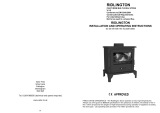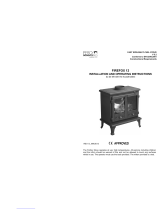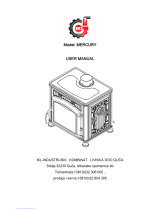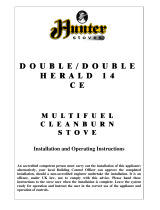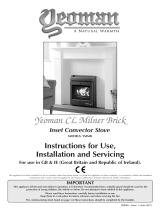Page is loading ...

16
Output Output kW
Brunswick
Cycle
Hours
Anthracite
4.6 4
Wood Logs (less than 20% moisture)
4.9 1
Coal (E)
4.3 4
Peat (E)
4.7 2
Closed Fire Briquettes
4.6 4
Outputs stated are under ideal test conditions. Variations will occur due to installation, atmospheric condi-
tions and fuel quality.
(E) - estimate calculated
Flue Gas
Temp at
Spigot
Flue Gas
Mass Flow
Flue Diam Ventilation
Reqt
Ventilation Reqt
with draught
stabilizer
Brunswick 446
O
C 3.4 g/s (wood)
4.7 g/s (ancit)
125mm
5 inches
None 1500mm
2
2.33in
2
As tested to the requirements of EN13240 for intermittent use.
Valor Fires
Wood Lane
Erdington
Birmingham
B24 9QP
Tel. 01204 868550 (technical and spares enquiries)
www.valor.co.uk
BRUNSWICK
CAST IRON MULTI-FUEL STOVE
V 5.2
Conforms to EN13240:2001
Constructional Requirements
For Intermittent Use
Not to be used in a shared flue
BRUNSWICK
INSTALLATION AND OPERATING INSTRUCTIONS
(to be left with the householder)
FIRES CAN BE DANGEROUS –The Brunswick Stove operates at very high temperatures.
Always use a fire guard to BS6539 specification in the presence of children, the elderly of the
infirm. Inform all persons the dangers of high temperatures during operation of appliance in-
cluding the stove pipe use operating tools provided. The mitten provided is a tool.
APPROVED

2
Parts List
37
38
35
36
15
Dimensions
Dimensions,
mm
A B C D E F G
Weight Max Fuel
Load
Anthracite
Minimum Flue
Draught
Brunswick
560 412 206 440 374 102 131 70 Kg 5.33 Kg 12 Pa
0.048 In Wg
Dimensions may vary slightly, the manufacturers reserve the right to adjust them without notice.
Key To Dimensions
A—Height
B—Width
C—Centreline of Flue
D—Height To Centre of Rear Flue
E—Depth
F—Rear to Centre of Top Flue
G—Flue Diameter
See back page for flue data,
ventilation requirements and
stove outputs
Flue pipe requirement (minimum) diameter:
125mm (5 inch) nominal diameter

14
Typical Installation Into Infilled Masonary Fireplaces
Soot Door
Seal with fireproof lagging
Max150mm
Infill
45 deg minimum
3
1 FFX008 Flue Collar
2 FFX009 Flue Blanking Plate
3,5,6 FFX001 Stove Body (Rear,Right,Left Panel)
4 FFX003 Stove Top Panel
7 FFX002 Stove Base Panel
8 FFX005 Grate Support Plate
9 FFX006 Grate
10 FFX007 Stove Baffle Plate
11 FFX012 Side Brick
12 FFX013 Back Brick
13 FFX010 Leg
14,15 D11C002 Stove Door + Front Panel
16 FFX014 Ash Pan
17 FFX011 Fret
18 FFX024 Secondary Air Duct
19 FFX018 Door Glass
20 FFX027 Glass Panel Seal
21 FFX026 Door Seal
22 FFX023 Secondary Air Slide
23,26,30 FFX022 Primary, Secondary + Riddling Knob Set
24 FFX021 Locating Strip
25 FFX020 Primary Air Slide
27 FFX029 Operating Tool
28 FFX1 Mitten
29 FFX015 Grate Riddling Rod
31 FFX017 Door Catch
32 FFX019 Door Glass Retaining Tabs
33 FFX028 Hinge Pin
34 - Stove Identification Label (non-replaceable part)
31a D11C010-A Door Handle (Brushed Steel)
31b D11C010-B Door Handle (PVD)
Brunswick Parts List

4
Assembly Of Stove
Remove legs, collar and blanking plate from stove and fit in desired position. The collar
can be fitted top or rear.
The legs can be fitted at front of ash lip or rearward. To make easier for handling on
installation, remove baffle plate, side bricks, back brick and door. Place in a secure
place to avoid damage.
Refit after installation.
Stove Installation, Operating & Maintenance Instructions
IMPORTANT: THIS APPLIANCE MUST BE INSTALLED BY A COMPETENT PER-
SON AND MUST COMPLY WITH NATIONAL BUILDING REGULATIONS AND LO-
CAL BY-LAWS. UNLESS THE INSTALLER IS QUALIFIED TO APPROVE INSTAL-
LATION THEN APPROVAL MUST BE SOUGHT FROM YOUR LOCAL BUILDING
CONTROL DEPARTMENT. THE SUPPLIERS ACCEPT NO RESPONSIBILITY IF
THIS ADVICE IS NOT COMPLIED WITH.
THIS APPLIANCE HAS BEEN EXTENSIVELY TESTED FOR SAFETY AND EFFI-
CIENCY, DO NOT ATTEMPT TO MODIFY IT. ALWAYS USE GENUINE REPLACE-
MENT PARTS AS RECOMMENDED BY YOUR SUPPLIER. FAILURE TO ADHERE
TO THIS ADVICE COULD INVALIDATE YOUR GUARANTEE.
Installation Instructions
Check the chimney is in good condition, dry, free from cracks and obstructions. The
diameter of the chimney flue should not be less than 150mm and not more than
230mm. If any of these requirements are not met, the chimney should be lined by a
suitable method.
The chimney height and the position of the chimney terminal should conform to Building
Regulations.
A flue draught of minimum 12 Pascals and a maximum of 15 Pascals water gauge is
required for satisfactory appliance performance. The flue draught should be checked
under fire at high output and if it exceeds the recommended maximum, a draught stabi-
liser must be fitted so that the rate of burning can be controlled, and to prevent overfir-
ing.
If you have any doubts about the suitability of your chimney, consult your local dealer/
stockist.
The chimney must be swept before connection to the stove and checked every six
months there after. If there is an excessive build up of soot, then the chimney must be
13
Typical Installation For Inglenook Fireplaces
Inglenook fireplaces can have very large bore chimneys. Check with
your installer—you may need a stainless steel flexible liner for solid fuel
fitting.
Closure
Plate
Seal

12
Installation Diagrams
Typical Top Flue Installation using steel closure plate incorporating
clean out door for chimney sweeping
Seal with
fireproof
Max
150mm
Infill
Typical Rear Flue Installation with clean out door
5
swept and the reason for build up investigated.
An existing fireplace opening can be bricked up or sealed with a register plate, 1.5mm
steel sheet or concrete. A short length of flue pipe no smaller in diameter then the stove
flue outlet or the manufacturer’s stated flue size may then be used to connect the stove
to the chimney. This flue pipe should be of cast iron, 316 grade stainless steel or vitre-
ous enamelled, nominal thickness 1.2mm. Ensure that the pipe end is no closer than
76mm to the side or rear chimney walls.
Ideally, the old fireplace should be filled in so that there is a smooth streamlined entry
into the flueway.
The length of any horizontal run of the flue pipe must not exceed the flue outlet diame-
ter on the stove.
It is essential that all connections between the stove and chimney-flue are sealed and
made airtight.
Both chimney and flue pipe must be accessible for cleaning and if ALL parts of the
chimney cannot be reached through the stove, a soot door must be fitted to enable this
this to be done.
The Primary Air Sealing Plate is located on the front of the grate. To locate in position,
slacken the two screws beneath the grate and pull forward, then close the door fully,
open door and tighten screws.
Positioning of Appliance
The stove can be recessed in a suitable sized fireplace but a permanent free air gap of
at least 100mm must be left around the sides and top to obtain maximum heat output
and for access to the rear of the stove. There should not be any combustible material
within a distance of 600mm from any surface of the stove. Furniture and general soft
furnishings should not be within 900mm of any of the stove surfaces including the stove
pipe. In all instances the stove should be positioned on a non-combustible hearth. Allow
an apron of at least 300mm at the front of the stove and 150mm on either side. The
hearth on which the stove is to be placed should not be less than 125mm thick if the
floor is made of combustible material, and care should be taken to level the stove and
secure the hearth. If existing floors do not have adequate load bearing capacity then
suitable modifications to load bearing plates must be adopted.
When the stove is desired position mark hearth through holes in feet, remove stove drill
and plug hearth for securing stove and levelling. See typical flue connection methods
illustrated.
Upon completion of installation, the appliance should be checked under fire for sound-
ness of joints and seals, and also that all smoke and fumes are taken from the appli-
ance, up the chimney and emitted safely.
Care should be taken that all flues, hearths and combustion air supplies are in accor-

6
dance with the current Building Regulations, Local Authority By-laws, British Standards
and Codes of Practice. The Brunswick has no ventilation requirement but a fixed vent is
advisable as this will enhance the pull of the chimney and reduce unwanted draughts.
Care should be taken that these openings can not become obstructed. Considerations
and provisions must be made for any other appliances requiring ventilation. An extractor
fan must not be used in the same location as the appliance.
This appliance is not to be used with a shared chimney.
Operating Instructions
Primary Air
Primary air is controlled via the sliding vents in the bottom of the door; this provides a
conventional air draught to the bed of the fire. (+) indicates more air, (-) indicates less
air. To adjust, slightly turn the knob anti-clockwise to loosen, then move sideways.
When in the desired position, turn the knob clockwise until tight.
Secondary Air
Secondary air is controlled via the sliding vent above the door, it is this ‘airwash’ that
keeps a clean and uninterrupted view of the fire, also aiding in good secondary combus-
tion of fuel and reducing emissions into the chimney and environment. To adjust the
secondary air intake, simply move the slider left (-) for less air or right (+) for more air.
Damper Assembly (optional)
When burning wood only, a flue damper assembly may be fitted. When the damper is
set in the open position the chimney draws at full draught, increasing the volume of air
flow through the stove and flue. Shutting the damper restricts the flow, slowing the rate
of burning. This is an after market product and will be of the type with positive open and
closed indication to prevent misunderstanding.
THE FLUE DAMPER SHOULD NOT BE FITTED WHEN BURNING SOLID FUELS
De-Ashing
It is important that the riddler is used to remove the ash to ensure an airflow through the
firebed and allow the fire to burn over the entire area of the grate. Insert peg on operat-
ing tool into hole in riddling rod, draw tool forwards and backwards with a slow positive
action. Set rod in back position after de-ashing.
Notes On Wood Burning
Wood burns best on a bed of ash and it is therefore only necessary to remove surplus
ash from the grate occasionally.
Burn only dry, well seasoned wood, which should have been cut , split and stacked for
at least 12 months, with free air movement around the sides of the stack to enable it to
dry out. Burning wet or unseasoned wood will create tar deposits in the stove and chim-
ney and will not produce a satisfactory heat output.
11
problem is solved. A list of Qualified Engineers is available from:
UK Solid Fuel Association
7 Swanwick Court, Alfreton
Derbyshire DE557AS
Tel- 0845-601-4406
R.o.I.
Irish National Fireplace Organisation
162 Chapel Street, Dublin
Tel-01-801-5959
5) Chimney Fire
Identified by loud roaring sounds, dense smoke and sparks exiting chimney. Shut
down air supply to stove by closing air vents, close stove door fully, call fire bri-
gade immediately. Regular chimney maintenance will prevent chimney fires.
Seek advice from a Qualified Chimney Sweep. Chimneys must be checked annu-
ally more often when bitumas coal and poor quality smoky fuels are used.
If this appliance is well maintained and used correctly in accordance with these
instructions it will give many years of efficient service and prove to be an excel-
lent investment.

10
flue pipe must be swept at least once a year.
To avoid a build up of soot on the baffle (the plate inside the stove above the grate)
this must be removed and cleaned periodically. This plate locates the back and side
firebricks so note its position before removal. To remove, lift plate and remove one
side brick, this will allow plate to drop and aid removal. To replace, position baffle plate
on back and side brick, lift plate and replace remaining brick, make sure it has located
in position. This must be done when the stove is cold.
For efficient burning of your appliance, make sure the grate is clear of burnt debris i.e.
nails etc.
Troubleshooting
1) Poor heat output
A) Stove too small for a room.
Seek advise from a Qualified Heating Engineer as to (KW) output required for
room size as a guideline the volume of the room in cubic feet divided by 500 i.e.
room 15’x15’x8’ would require 3.6kw approx.
B) Chimney and/or flue pipe restricted, room ventilation restricted.
On installation these will have been checked but regular maintenance is neces-
sary as conditions can change i.e. soot build up, birds nesting, masonry fall,
dust build up or furniture blocking vents.
C) Poor quality fuel.
Only burn dry seasoned timber, soft woods have a lower heat output then hard
woods per hour. Solid fuels vary in heat value check with your coal merchant as
to suitability.
2) Dirty Glass Panel
A) Generally caused by poor fuel quality, see (1c)
B) Use secondary air slide (Airwash) for glass panel
C) Fire burning to low, open air vents on stove create hot fire this may ‘burn’ glass
clean.
D) If glass requires cleaning use glass cleaner recommended by your supplier,
only use glass cleaner or cold glass. DO NOT USE any abrazifs or scrapers these
will scratch glass causing tar build up harder to remove.
3) Unburnt Fuel In Firebox
Insufficient air reaching fuel. Open primary air slide, this will supply combustion air
to burn fuel fully (unless it has reached a ‘point of return’)
Check ash pan is full, empty if required, grate may be blocked de-ash with riddler,
check for jammed clinker or nails in grate when fires out and cold.
4) Smoke And Fumes Entering Room
These are very dangerous and must NOT be tolerated. Open window and allow
fire to burn out, seek expert advice immediately. DO NOT USE stove until the
7
Notes On Solid Fuel Burning
Always de-ash before refuelling and do not let the ash build up to the underside of the
grate bars. Solid fuel produces ash, which if allowed to build up will stifle the air flow
through the grate and eventually cause the fire to die.
With some solid fuels a residue of burnt fuel or clinker will accumulate on the grate, al-
low the fire to go out periodically to remove this.
We cannot stress firmly enough how important it is to empty the ash pan regularly. Air
passing through the firebed cools the grate. Distortion or burning out the grate bars is
nearly always caused by ash being allowed to build up the underside of the grate.
Recommended Fuels
Seasoned wood—moisture content less than 20%
Solid fuel—Anthracite large nuts, briquette smokeless fuel i.e. Ancit, Phurnacite, Tay-
brite, Homefire Ovals suitable for closed appliances.
Please note that when refuelling with solid fuel do not pile fuel higher than 30 degrees
from the front bar rearwards—overfuelling can produce temperatures beyond the de-
signed rating of the appliance, causing damage to internal parts.
Lighting The Stove
We recommend that you have two or three small fires before you operate your stove to
its maximum heat output. This is to allow the paint to cure and castings to relax and con-
solidate location we recommend ‘running in’ procedure after long shutdowns to preserve
life of stove. During this you may notice an unpleasant smell. It is not toxic, but for your
comfort we would suggest that during this period you leave all doors and windows open.
First, load the fire with starting fuel i.e. paper, dry kindling timber and/or fire lighters in
the mode chosen, either wood or coal.
Light the fire at base leaving all air controls open. Allow the fuel to reach a steady glow
and build the fire up gradually. Once you have a good fire established across the grate
bed, further fuel can be added as required.
When your fuel is well alight you can start to restrict the primary air intake. If you are
burning only wood, the primary air control can be fully closed. If you are burning solid
fuel you will require more primary air. Your stove is burning with maximum efficiency
when a bright fire is achieved using minimum air inlet.
The stove can be banked up for long periods. When burning solid fuel empty the ash-
pan. Open air controls and let the fire burn brightly for a short period. Refuel and close
air controls, the exact setting required will depend on the fuel used and the chimney
draw so some practice may be necessary. To revive the fire, open air controls until the
fire is burning brightly, de-ash if necessary (solid fuel only) and refuel. Set air controls as
required.
This appliance is designed to be operated with the door closed. Except for refuelling, not
only is it unsafe to operate with the door open but the appliance efficiency will be re-
duced dramatically.

8
Solid Fuels
We recommend the majority of approved manufactured smokeless fuels. Household
coal, which is ‘Smokey’ fuel, can also be used but note that different types will give
different performances. Use as an incinerator is not recommended as fumes from plas-
tics etc will cause pollution to the atmosphere and will damage stoves internals.
PETROLEUM COKE FUELS OR HOUSEHOLD WASTE SHOULD NOT BE BURNT
ON THIS APPLIANCE
Should any difficulties arise over fuel quality or suitability, consult your local supplier or
the Solid Fuel Advisory Service.
Safety Notes For Your Guidance
FIRES CAN BE DANGEROUS –Always use a fire guard to BS6539 specification in the
presence of children, the elderly of the infirm.
Inform all persons the dangers of high temperatures during operation of appliance in-
cluding the stove pipe use operating tools provided.
DO NOT OVER FIRE—it is possible to fire the stove beyond its design capacity, this
could damage the stove, so watch for signs of overfiring—if any part of the stove starts
to glow red, the fire is in an overfire situation, and the controls should be adjusted ac-
cordingly. Never leave the stove unattended for long periods without adjusting the con-
trols to a safe setting—careful air supply control should be exercised at all times.
Warning—Fume Emissions
Properly installed and operated, this appliance will not emit fumes. Occasional fumes
from de-ashing and refuelling may occur. Persistent fume emission must not be toler-
ated.
If fume emission does persist, then following immediate action should be taken—
1. Open doors and windows to ventilate the room.
2. Let the fire out, or eject and safely dispose of fuel from the appliance.
3. Check for flue chimney blockage, and clean if required.
Do not attempt to relight the fire until the cause has been identified. If necessary, seek
professional advice.
DO NOT FIT AN EXTRACTOR FAN IN THE SAME ROOM AS THIS APPLIANCE
Seasonal Maintenance
If the appliance is not to be used for any length of time, e.g. summer months, then it is
recommended that the appliance is cleaned out thoroughly. Air slides should be lightly
oiled and left partially open to allow circulation of air. Regular monitoring of internals
will highlight condensation problems or water ingress. If these problems occur then the
appliance needs drying and the cause of the problem investigating. It is advisable that
after a seasonal shutdown the appliance is re-cleaned. Remove baffle plate, brick lin-
ings, check operation of grate, check flue for any possible blockages. It is advisable to
have the chimney swept at least once or even twice per year. If the appliance is in con-
9
stant use, the use of bitumas coal or poor quality wood makes flues soot and tar up
more frequently.
Basic maintenance can be carried out by the appliance operator, i.e removal of baffle
plate, bricks, grate, glass replacement and must be done when the appliance is cold.
Any structural repairs, i.e. panel collar replacement or stove pipe must be carried out
by a suitably qualified engineer.
General Maintenance
Baffle Plate
This should be removed at least once a month to prevent any build up of soot or fly
ash which could lead to blocked flueways and dangerous fume emission. If the baffle
plate is removed the chimney/flueway can be swept through the appliance.
Baffle Plate Removal and Replacement
Note position before removal. To remove baffle plate, lift up and remove one side brick
left or right. The baffle plate can now be manipulated out of the stove door opening.
Remove the remaining back and side brick—as the bricks are free-standing no dam-
age can now occur due to bricks falling over.
To replace, place rear brick in position and one side brick. Manipulate baffle into posi-
tion and fit remaining sode brick. Make sure all parts are located.
Grate Removal
The Brunswick has a single rotating grate operated by an attached riddling rod. To
remove, unscrew control knob and rotate grate out of its guide hole. The centre grate
can now be removed. To replace grate, reverse this procedure. Note position of grate
riddling rod as it connects to grate. The hook on the end of the rod passes under and
up through the arm hole on the grate. If the removal of the outer grate is required then
the baffle plate, rear and side bricks will require removal. The outer grate will then lift
out off it’s stops.
Stove Body
The stove is finished with a heat-resistant paint and this can be cleaned with a soft
brush. Do not clean whilst the stove is hot, wait until it has cooled down. The finish can
be renovated with a suitable brand of paint.
Glass Panels
Clean the glass panels when cool with a proprietary glass cleaner. Highly abrasive
substances should be avoided as these can scratch the glass and make subsequent
cleaning more difficult. Wet logs on heated glass, a badly aimed poker or heavy slam-
ming of the doors could crack the glass panels. The glass will not fracture from heat.
Chimney
Check your chimney each year before starting to use your stove for the winter. Birds
may have nested in the chimney or the masonry may have cracked. Both chimney and
/
